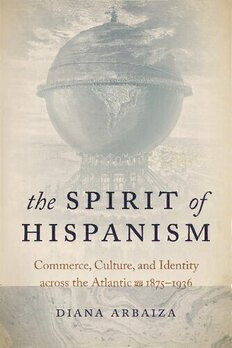
The Spirit of Hispanism: Commerce, Culture, and Identity Across the Atlantic, 1875-1936 PDF
Preview The Spirit of Hispanism: Commerce, Culture, and Identity Across the Atlantic, 1875-1936
THE SPIRIT OF HISPANISM the S P I R I T of H I S P A N I S M Commerce, Culture, and Identity across the Atlantic, 1875–1936 DIANA ARBAIZA UNIVERSITY OF NOTRE DAME PRESS NOTRE DAME, INDIANA Copyright © 2020 University of Notre Dame University of Notre Dame Press Notre Dame, Indiana 46556 undpress.nd.edu All Rights Reserved Library of Congress Cataloging-in-Publication Data Names: Arbaiza, Diana, 1980- author. Title: The spirit of Hispanism : commerce, culture, and identity across the Atlantic, 1875–1936 / Diana Arbaiza. Description: Notre Dame, Indiana : University of Notre Dame Press, 2020. | Includes bibliographical references and index. Identifiers: LCCN 2019054581 (print) | LCCN 2019054582 (ebook) | ISBN 9780268106935 (hardback) | ISBN 9780268106966 (adobe pdf) | ISBN 9780268106959 (epub) Subjects: LCSH: Pan-Hispanism—History. | Latin America—Relations—Spain. Spain—Relations—Latin America. Classification: LCC F1416.S7 A725 2020 (print) | LCC F1416.S7 (ebook) | DDC 327.8046—dc23 LC record available at https://lccn.loc.gov/2019054581 LC ebook record available at https://lccn.loc.gov/2019054582 This e-Book was converted from the original source file by a third-party vendor. Readers who notice any formatting, textual, or readability issues are encouraged to contact the publisher at [email protected]. CONTENTS List of Illustrations vii Acknowledgments ix Introduction 1 one. Hispanism as Vindication: Spain as Other in 30 the Age of Commerce two. The Emergence of Hispanic Idealism, 1892–1900 64 three. Complicated Harmonies: Economic and Cultural 116 Initiatives in Progressive Hispanism four. Ramiro de Maeztu and the Search for a Hispanic 154 Economic Ideology five. Commercial Hispanism: Marketing Spiritual Capital 187 Afterword 238 Notes 245 Works Cited 263 Index 286 IILLUSTRATIONS Figure 1. Allegorical Float at the Centennial of 1892 69 Figure 2. Scenes from the Parade of Commerce and Industries in Madrid at the Centennial of 1892 73 Figure 3. Cartoon Parodying the Centennial Celebrations in Madrid 74 Figure 4. Cartoon of Columbus in an Advertisement 75 Figure 5. Allegorical Representations of Spain and Spanish America in El Centenario 83 Figure 6. Caricature of the United States in La Campana de Gracia 96 Figure 7. Design for a Proposed Monument to the “Discovery” for the Chicago Exhibition of 1893 99 Figure 8. Illustration for an Article on Rodó, Author of Ariel 108 Figure 9. Illustration of the Metaphor of Sisterhood “from Nation to Nation” 192 Figure 10. Cover designs for Mercurio 202 Figure 11. Front Cover of How Spain Is Loved (1920) 207 vii ACKNOWLEDGMENTS I would like to start by thanking my editor, Eli Bortz, for believing in this project, and the team at Notre Dame for making it possible. Throughout the long process of creating this book, many people have influenced my ideas, but I would like to give special credit to those who had the most direct impact. I am the only one responsible for any errors in this work, but the following people inspired the best aspects of this project. Even though this book departed enormously from my doctoral dis- sertation, the intellectual foundation behind it is undoubtedly shaped by my professors at the University of Illinois: Elena Delgado, Joyce Tolliver, and Mariselle Meléndez. Special thanks to Michael Palencia- Roth, who inspired me to research cross-cultural exchanges, and to my advisor, E ricka Beckman, who guided me into new theoretical fields and venues of inquiry. I feel very grateful for her ongoing mentorship and for her valuable feedback on this project. This book would not have been possible without the support of my colleagues in the Department of Foreign Languages and Literatures at North Carolina State University. I thank Ruth Gross for her endeavors to facilitate my research and for the time and means made available for my archival work in Spain. Even more important was the stimulating and encouraging environment at NC State. I benefited enormously from the exchange with all my colleagues, but I would like to particu- larly mention Agustín Pastén and Patricia Morgado, as well as Shelley Garrigan, who read several chapters of the book and gave me the sharp- est and most constructive criticism. I am profoundly indebted to Elvira Vilches and Jordi Marí for their brilliant scholarly inspiration and their generosity as friends. Our conversations on literature, economy, and ix
